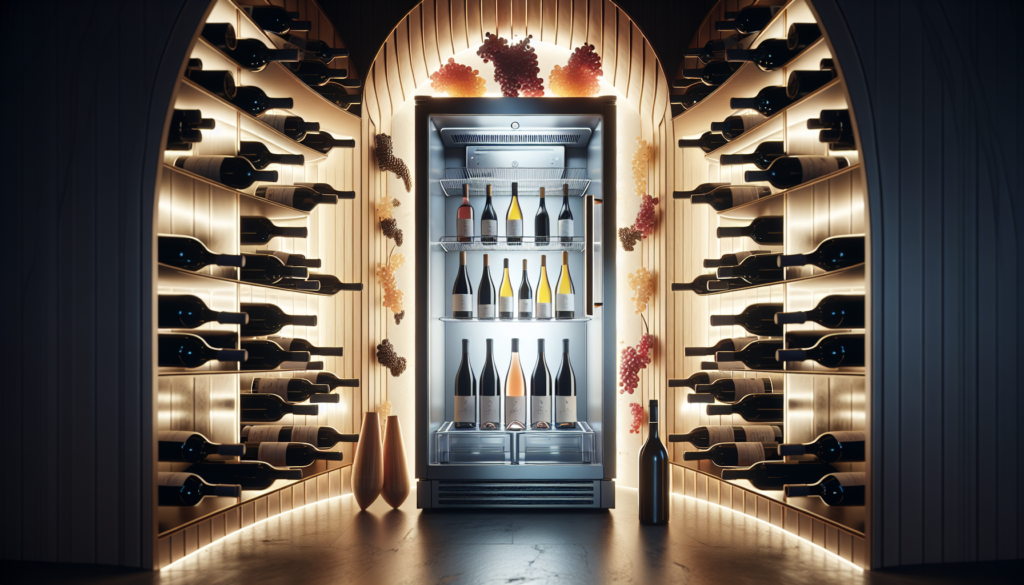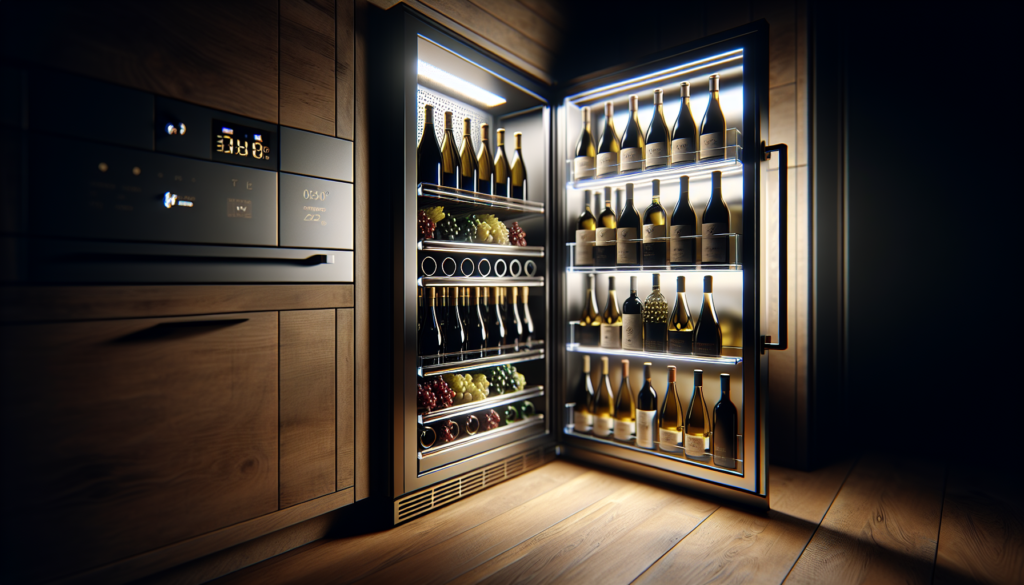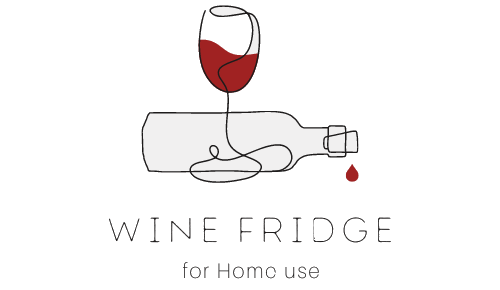Whether you’re hosting a dinner party or simply enjoying a glass of wine at the end of a long day, the temperature at which your wine is stored can greatly impact its taste and overall enjoyment. In this article, we’ll discuss the importance of wine fridge settings and how to ensure that your wine is stored at the optimal temperature for maximum flavor and aroma. So grab a glass and get ready to discover the secrets to perfectly chilled wines!
Temperature
Ideal Temperature Range
When it comes to storing wine, maintaining the right temperature is crucial. The ideal temperature range for wine storage is typically between 45°F and 65°F (7°C to 18°C). This range ensures that your wine matures gracefully and does not develop any off-flavors. Keeping your wine at a consistent temperature within this range is essential to preserving its quality and taste.
Cooling Zones
Some wine fridges come with multiple cooling zones, allowing you to store different types of wine at their ideal temperatures simultaneously. This feature is especially useful if you have a diverse wine collection that includes both red and white wines. By utilizing different cooling zones, you can create distinct microclimates within your wine fridge to cater to the specific temperature requirements of each type of wine.
Temperature Fluctuations
Temperature fluctuations can have a detrimental effect on your wine. Rapid changes in temperature can cause the wine to expand and contract, which can lead to oxidation and spoilage. Keeping your wine fridge in a location where it is not exposed to direct sunlight or extreme temperature changes is crucial to ensuring that the temperature remains consistent. Additionally, avoid opening the door frequently as it may cause temperature fluctuations within the fridge.
Humidity
Importance of Humidity
Humidity plays a vital role in wine storage as it helps prevent the cork from drying out. If the cork dries out, oxygen can seep into the bottle, causing the wine to lose its flavors and aromas. Maintaining the right humidity level in your wine fridge ensures that the corks remain moist, preserving the quality of your wine.
Recommended Humidity Levels
The ideal humidity level for wine storage ranges between 50% and 75%. This range helps to prevent the corks from drying out without promoting mold growth or condensation buildup. If the humidity falls below 50%, you may need to consider using a humidifier or placing a bowl of water in the wine fridge to increase the moisture level.
Managing Humidity
To maintain the proper humidity level in your wine fridge, avoid placing it in a dry environment or near sources of heat or excessive moisture. Regularly check the humidity levels using a hygrometer and make adjustments as necessary. If the humidity level is too low, consider using a humidifier or a specialized wine fridge with humidity control features.

Vibration
Impact of Vibration
Excessive vibration can disturb the sediments in wine bottles, affecting the aging process and ultimately the flavor and quality of the wine. Vibrations can agitate the molecules in the wine, leading to premature aging or even spoilage. It is crucial to minimize vibrations in your wine fridge to ensure that your wines age properly and develop the desired characteristics.
Minimizing Vibration
To minimize vibrations, place your wine fridge on a sturdy and level surface. Avoid positioning it near appliances or equipment that generate vibrations, such as washing machines or air conditioning units. Additionally, consider using vibration-dampening materials, such as rubber pads or mats, underneath the wine fridge to absorb any residual vibrations.
Vibration Control Strategies
If you are storing wines that are particularly sensitive to vibrations, such as older vintages or delicate varietals, you may want to invest in a specialized wine fridge with advanced vibration control features. These fridges are designed with insulation materials and components that minimize internal vibrations, ensuring the optimal storage conditions for your valuable wine collection.
Lighting
Light Exposure Effects
Exposure to light, especially ultraviolet (UV) light, can have detrimental effects on wine. UV rays can degrade the wine’s organic compounds and lead to a phenomenon known as “lightstrike.” This can result in unpleasant off-flavors and the degradation of the wine’s color. Protecting your wine from direct and prolonged exposure to light is essential for maintaining its integrity.
Types of Lighting
When it comes to lighting in your wine fridge, it is best to use LED lights. LED lights emit little to no UV radiation and produce minimal heat compared to traditional incandescent or fluorescent lights. This ensures that your wines are not exposed to unnecessary heat or harmful UV rays, preserving their taste and quality.
Best Practices for Lighting
To further minimize light exposure, consider choosing a wine fridge with a UV-resistant glass door or solid door that limits light transmission. Additionally, avoid placing your wine fridge in direct sunlight or areas with excessive artificial lighting. By following these best practices, you can protect your wines from light damage and ensure their optimal aging and quality.

Shelving and Positioning
Materials of Shelves
The material of the shelves in your wine fridge can impact the overall quality of your wine storage. Opt for shelves made of wood or metal, as they offer better support and stability compared to plastic shelves. Wood and metal shelves also have the advantage of absorbing vibrations, reducing any potential disruptions to your wine collection.
Shelf Positioning
When organizing your wine fridge, ensure that there is enough space between bottles to allow for proper air circulation. The spacing also prevents labels from rubbing against each other and potentially getting damaged. Position the bottles horizontally on their sides, as this helps keep the corks moist and prevents oxidation. Proper shelf positioning is crucial for maintaining the integrity of your wine collection.
Air Circulation
Proper air circulation within the wine fridge is important for maintaining a consistent temperature and humidity. Avoid overcrowding the shelves with too many bottles, as this can impede the flow of air and lead to uneven cooling and humidity distribution. Leave some space between the bottles and ensure that there are no obstructions that could block the air vents of the wine fridge.
Ventilation
Proper Ventilation Importance
Proper ventilation is essential to prevent the buildup of stagnant air and maintain a healthy environment inside your wine fridge. Good ventilation ensures consistent cooling, prevents the accumulation of odors, and helps maintain the desired temperature and humidity levels. Without adequate ventilation, your wine may be susceptible to spoilage and unpleasant aromas.
Ventilation Systems
Most modern wine fridges come equipped with built-in ventilation systems that ensure proper airflow. These systems typically include fans and vents that facilitate the circulation of air, helping to maintain optimal storage conditions. It is important to keep these ventilation systems free from dust and debris to ensure their efficient operation.
Ventilation Maintenance
Regularly inspect and clean the vents of your wine fridge to prevent any blockages that may impede airflow. Use a soft brush or cloth to remove any dust or dirt that has collected on the vents. Additionally, ensure that the wine fridge is not positioned against a wall or in an enclosed space, as this can restrict proper ventilation.
Energy Efficiency
Energy Consumption
Wine fridges can consume a significant amount of energy, so it is important to consider their energy efficiency. Look for wine fridges with high energy efficiency ratings, as they will consume less electricity and help reduce your carbon footprint. Energy-efficient wine fridges often feature insulation, LED lighting, and advanced temperature control systems to minimize energy consumption.
Making the Fridge Efficient
To make your wine fridge more energy-efficient, avoid frequent opening of the door as it can cause temperature fluctuations and lead to increased energy consumption. Ensure that the door seals are tight and free from any leaks that may allow warm air to enter or cool air to escape. Additionally, place your wine fridge away from heat sources, such as ovens or direct sunlight, as this can make the cooling system work harder and consume more energy.
Eco-Friendly Practices
In addition to choosing an energy-efficient wine fridge, there are other eco-friendly practices you can adopt to reduce your environmental impact. Consider grouping your wines by varietal or region to minimize the need to open the door and search for a specific bottle. This reduces unnecessary energy consumption and helps maintain a more consistent temperature within the wine fridge. Additionally, recycle any packaging materials and opt for sustainable wine producers who prioritize environmentally friendly practices.
Temperature Control
Thermostat Settings
The thermostat settings of your wine fridge play a crucial role in maintaining the desired temperature. It is recommended to set the thermostat within the ideal temperature range of 45°F to 65°F (7°C to 18°C). However, fine-tuning the settings may be necessary depending on the location and ambient temperature of the room where the wine fridge is placed.
Adjusting the Temperature
Factors such as seasonality and fluctuating room temperatures can impact the internal temperature of your wine fridge. It is important to periodically monitor the temperature and adjust the thermostat settings accordingly. By using a digital thermometer, you can accurately measure the temperature inside the wine fridge and make any necessary adjustments to ensure optimal storage conditions for your wine collection.
Monitoring Tools
To ensure that your wine fridge is maintaining the desired temperature, it is advisable to use additional monitoring tools such as temperature alarms or data loggers. These tools can provide real-time alerts or track temperature fluctuations over time, allowing you to take immediate action if there are any deviations from the desired storage conditions. With these monitoring tools, you can have peace of mind knowing that your wines are being properly preserved.
Safety and Security
Child Lock Features
If you have young children at home, it is important to consider a wine fridge with child lock features. These locks prevent unauthorized access and keep curious little ones from getting into the wine fridge. By using a child lock feature, you can ensure the safety of your children and the integrity of your wine collection.
Door Locks
For enhanced security and protection, some wine fridges come equipped with door locks. These locks add an extra layer of security, preventing unauthorized individuals from gaining access to your wine collection. A wine fridge with a door lock is particularly useful if you have valuable or rare wines that require added security measures.
Temperature Alarms
Temperature alarms are another important safety feature to consider in a wine fridge. These alarms will alert you if there is a sudden temperature change or if the temperature deviates from the desired range. By promptly addressing any temperature fluctuations, you can prevent potential damage to your wine collection and ensure that it remains in optimal condition.
Cleaning and Maintenance
Regular Cleaning Routine
Maintaining a regular cleaning routine is essential for keeping your wine fridge in top condition and ensuring a safe environment for your wines. Start by unplugging the appliance and removing all the bottles. Wipe down the interior surfaces, including the shelves and door seals, using a mild detergent or vinegar solution. Rinse thoroughly and allow the fridge to dry completely before reassembling and restocking.
Filters and Maintenance
Some wine fridges come with built-in filters, such as charcoal filters, to help remove odors and maintain air quality. It is important to regularly clean or replace these filters to ensure their effectiveness. Check the manufacturer’s instructions for guidelines on when and how to clean or replace the filters. Additionally, inspect the seals around the door regularly to ensure they are not cracked or worn, as this can impact the fridge’s efficiency.
Defrosting
If your wine fridge is not of the auto-defrost type, it may require periodic defrosting to remove any ice buildup. Excessive ice can hinder the proper functioning of the cooling system and affect the temperature control. Follow the manufacturer’s instructions on how to defrost your wine fridge, which may involve turning it off and allowing the ice to melt naturally. Once defrosted, clean the interior and ensure that it is completely dry before turning the fridge back on.
In summary, maintaining the ideal temperature, humidity, and lighting conditions is crucial for preserving the quality and taste of your wine. By minimizing vibrations, ensuring proper ventilation, and adopting energy-efficient practices, you can create a favorable environment for your wine collection. Additionally, implementing safety and security features, regularly cleaning and maintaining the wine fridge, and monitoring the temperature can further enhance the longevity and enjoyment of your wines. Cheers to a well-cared-for wine collection!
